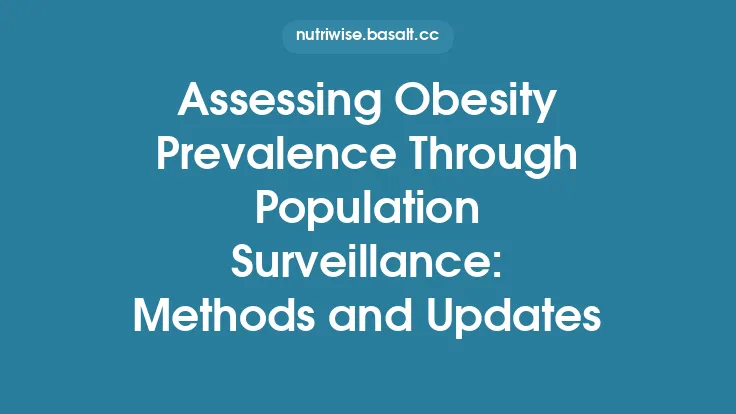Obesity remains one of the most pressing public‑health challenges of the 21st century, yet its distribution is far from uniform across the lifespan. Over the past several decades, researchers have documented striking shifts in the prevalence of excess adiposity among children, adolescents, adults, and older adults. Understanding these age‑specific dynamics is essential for designing targeted prevention strategies, allocating resources efficiently, and anticipating future health‑care burdens. This article synthesizes the current epidemiologic evidence on how obesity prevalence has changed across age groups, highlights methodological considerations that shape our interpretation of trends, and outlines emerging research directions that can refine surveillance and intervention efforts.
Historical Overview of Age‑Specific Obesity Trends
Early Surveillance Efforts
The systematic monitoring of body‑mass index (BMI) began in the United States with the National Health Examination Survey (NHES) in the 1960s, followed by the National Health and Nutrition Examination Survey (NHANES) in the 1970s. Parallel efforts in Europe (e.g., the WHO MONICA project) and Asia (e.g., the China Health and Nutrition Survey) provided the first cross‑national snapshots of BMI distributions. These early data sets established a baseline: obesity (BMI ≥ 30 kg/m²) was relatively rare among children (<2 %) and modest among adults (≈10 % in high‑income countries).
The “Obesity Wave” of the 1990s–2000s
From the late 1980s onward, a rapid rise in adult obesity was documented across most high‑income nations, with prevalence doubling or tripling within a single generation. Simultaneously, pediatric obesity began to climb, especially in school‑age children (5–12 years). By the early 2000s, the prevalence of obesity among U.S. adults reached ~35 %, while childhood obesity approached 18 % in the same population.
Recent Deceleration and Emerging Patterns
In the past decade, several high‑income countries have reported a plateau or modest decline in adult obesity prevalence, whereas many low‑ and middle‑income countries (LMICs) continue to experience steep increases, particularly among adolescents and young adults. Notably, older adults (≥65 years) have shown a slower rate of increase, but absolute prevalence remains high due to cohort effects—older cohorts who were overweight earlier in life are now aging into the senior population.
Methodological Foundations for Interpreting Age‑Specific Trends
Defining Obesity Across the Lifespan
- Children and Adolescents (2–19 years): The WHO growth reference and CDC growth charts use age‑ and sex‑specific BMI percentiles; obesity is defined as ≥95th percentile (or ≥ + 2 SD for WHO). For adolescents, the International Obesity Task Force (IOTF) cut‑offs provide a bridge to adult BMI thresholds.
- Adults (20–64 years): Standard BMI cut‑offs (≥30 kg/m²) are widely used, though some researchers advocate for ethnicity‑specific thresholds (e.g., lower cut‑offs for South Asian populations).
- Older Adults (≥65 years): BMI may underestimate adiposity due to sarcopenia; waist circumference (WC) and waist‑to‑height ratio (WHtR) are increasingly recommended as complementary measures.
Secular Trend Analyses
- Cross‑sectional Repeated Surveys: Comparing prevalence estimates from successive NHANES cycles or WHO STEPS surveys provides a straightforward view of change but can be confounded by sampling variations.
- Cohort‑Period‑Age (CPA) Models: Decomposing trends into age, period, and cohort effects helps distinguish whether observed changes are driven by aging, historical exposures, or generational shifts. For example, a strong cohort effect in adolescents suggests that those born after 1990 are at higher risk independent of current environment.
- Longitudinal Cohorts: Studies such as the Avon Longitudinal Study of Parents and Children (ALSPAC) or the Framingham Heart Study enable tracking of individual BMI trajectories, offering insight into critical windows of weight gain.
Data Quality and Harmonization
Standardizing measurement protocols (e.g., calibrated stadiometers, calibrated scales) and adopting uniform definitions across surveys are essential for comparability. Recent initiatives to harmonize BMI data across national health surveys (e.g., the Global Health Data Exchange) have improved the reliability of age‑specific trend estimates.
Age‑Specific Drivers of Obesity Prevalence Shifts
Early Childhood (0–5 years)
- Infant Feeding Practices: Early introduction of energy‑dense complementary foods and reduced breastfeeding duration have been linked to higher BMI trajectories.
- Parental Obesity: Genetic predisposition and shared household environments amplify risk.
- Screen Time and Sedentary Behaviors: Even in toddlers, increased exposure to screens correlates with higher caloric intake and lower physical activity.
School‑Age Children (6–12 years)
- School Food Environments: Availability of calorie‑dense snacks and sugary beverages in school cafeterias contributes to excess energy intake.
- Physical Activity Decline: Structured recess and after‑school sports have diminished in many regions, reducing daily energy expenditure.
- Socio‑economic Disparities: Children from lower‑income families often experience higher obesity prevalence due to limited access to healthy foods and safe play spaces.
Adolescents (13–19 years)
- Pubertal Hormonal Changes: Accelerated adiposity accrual during puberty can be amplified by obesogenic environments.
- Autonomy Over Food Choices: Increased purchasing power and exposure to marketing of high‑calorie foods intensify risk.
- Mental Health Intersections: Depression and anxiety, which rise during adolescence, are associated with emotional eating and weight gain.
Young Adults (20–34 years)
- Transition to Independence: College life and early career stages often involve irregular meals, increased fast‑food consumption, and reduced physical activity.
- Weight‑Gain “Freshman 15” Phenomenon: Empirical data suggest an average gain of 2–5 kg during the first year of college, a critical period for establishing long‑term weight trajectories.
- Sleep Deprivation: Chronic short sleep duration, common in this age group, is linked to hormonal dysregulation (leptin, ghrelin) and increased appetite.
Middle‑Age Adults (35–64 years)
- Metabolic Slow‑Down: Age‑related declines in basal metabolic rate and muscle mass predispose to weight gain if caloric intake is not adjusted.
- Occupational Sedentarity: Desk‑based jobs and commuting patterns reduce daily energy expenditure.
- Family Responsibilities: Caregiving demands can limit time for physical activity and promote reliance on convenience foods.
Older Adults (≥65 years)
- Cohort Effect: Many seniors were overweight in midlife, and the cumulative exposure translates into high obesity prevalence in older age.
- Changes in Body Composition: Loss of lean mass (sarcopenia) masks adiposity when using BMI alone; waist circumference becomes a more sensitive indicator.
- Medication‑Induced Weight Gain: Certain antihypertensives, antidiabetics, and psychotropics contribute to weight gain in this population.
Socio‑Demographic and Geographic Modifiers
Sex Differences
Across most age groups, males tend to have higher prevalence of overweight (BMI ≥ 25 kg/m²) during early adulthood, whereas females often exhibit higher obesity rates post‑menopause, reflecting hormonal influences and differential fat distribution.
Ethnicity and Race
- South Asian Populations: Higher visceral adiposity at lower BMI necessitates lower cut‑offs for obesity classification.
- African‑Descent Populations: Higher prevalence of obesity in adulthood, but lower rates in early childhood compared with European‑descent groups.
- Indigenous Communities: Frequently experience the highest age‑specific obesity prevalence, driven by rapid lifestyle transitions and historical trauma.
Urban vs. Rural Settings
Urbanization has been associated with higher obesity prevalence among children and adolescents, likely due to greater access to processed foods and reduced opportunities for active transport. Conversely, in some LMICs, rural adults still exhibit lower obesity rates, though this gap is narrowing.
Socio‑Economic Status (SES)
Higher SES is traditionally linked to lower obesity prevalence in high‑income countries, but the relationship reverses in many LMICs where wealthier families have greater access to calorie‑dense foods. Within age groups, low‑SES adolescents consistently show higher obesity rates, underscoring the need for equity‑focused interventions.
Public‑Health Implications of Age‑Specific Trends
Burden of Comorbidities
- Children and Adolescents: Early obesity predisposes to type 2 diabetes, dyslipidemia, and hypertension, shortening the latency to chronic disease.
- Adults: Obesity amplifies risk for cardiovascular disease, certain cancers, and musculoskeletal disorders, driving health‑care costs.
- Older Adults: Obesity exacerbates frailty, impairs mobility, and increases mortality risk when combined with sarcopenia (the “obesity‑sarcopenia” phenotype).
Economic Consequences
Age‑targeted obesity incurs distinct economic impacts: pediatric obesity imposes costs related to school health services and parental work loss, while adult obesity drives productivity losses and higher medical expenditures. Modeling studies suggest that preventing a 5 % reduction in adolescent obesity could avert billions in future health‑care spending.
Policy and Intervention Priorities
- Early Life: Promote exclusive breastfeeding, regulate marketing of infant foods, and support parental education on nutrition.
- School Settings: Implement mandatory nutrition standards, increase physical‑activity curricula, and restrict sales of sugar‑sweetened beverages.
- Workplace: Offer healthy cafeteria options, incentivize active commuting, and provide flexible schedules for exercise.
- Community for Seniors: Develop age‑friendly recreational spaces, screen for obesity using waist circumference, and integrate weight‑management counseling into routine geriatric care.
Emerging Research Directions
Life‑Course Modeling
Advanced statistical techniques (e.g., latent growth curve modeling, Bayesian hierarchical models) are being applied to integrate data from birth cohorts, school‑based surveys, and adult health examinations. These models can identify “critical periods” where interventions yield the greatest long‑term impact.
Precision Nutrition and Genetics
Genome‑wide association studies (GWAS) have identified > 300 loci linked to BMI, many of which exhibit age‑specific effect sizes. Combining polygenic risk scores with early‑life environmental data may enable personalized prevention strategies.
Digital Surveillance
Wearable devices and mobile health apps generate continuous activity and dietary data, offering real‑time monitoring of weight trajectories across age groups. While not yet standardized for epidemiologic surveillance, pilot studies demonstrate feasibility for detecting rapid weight gain in adolescents.
Intergenerational Transmission
Research is increasingly focusing on how parental obesity influences offspring risk through epigenetic mechanisms and intrauterine environment. Understanding these pathways could inform preconception and prenatal interventions.
Policy Evaluation Using Natural Experiments
Quasi‑experimental designs (e.g., difference‑in‑differences, regression discontinuity) are being employed to assess the impact of policies such as sugary‑drink taxes, school nutrition standards, and urban planning reforms on age‑specific obesity trends.
Concluding Remarks
The landscape of obesity prevalence is dynamic and highly stratified by age. While adult obesity has historically dominated public‑health discourse, the accelerating rise among children and adolescents signals a looming wave of early‑onset chronic disease. Conversely, the recent plateau in some adult populations offers a glimpse of what can be achieved through coordinated policy, community, and clinical actions. A nuanced understanding of age‑specific drivers, methodological rigor in trend analysis, and targeted interventions are essential to reverse the trajectory of obesity across the lifespan. Continued investment in longitudinal data collection, innovative analytic approaches, and equitable public‑health strategies will be pivotal in shaping a healthier future for all age groups.




